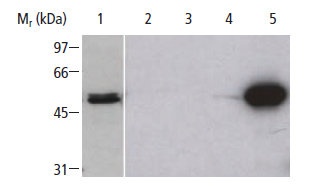Western Blot Example: Detecting or Characterizing Protein Expression

- On This Page
- Detecting or characterizing protein expression
Overview
One simple and common use for Western blotting is to identify whether a particular protein is present or absent in a sample by looking for a band of the correct size on a Western blot . This routine type of Western blot is used to either test for endogenous cellular expression of a target protein, or to examine transfected cell lines to see if expression has been conferred by the introduction of a DNA construct .
It is also used with techniques such as protein purification and cellular fractionation to identify which samples have the target protein, and thus is an aid to deciding which samples to combine or discard . After immunodetection, a band corresponding to the size of the target protein should become visible in positive test samples and the positive control, in comparison to a known null cellular sample . In the figure below, HEK293 cells transfected with three isoforms of the Homer 1 protein and are compared to rat cortical extract as a positive control .
The blot shows that the antibody used, Bio-Rad’s AHP737, recognizes Homer isoform 1c, but not 2b or 1a . The presence of untransfected cells (Lane 2) confirm that the signal is specific to transfection with the appropriate construct . The faint band seen in lane 4, is actually a small amount of spill over from lane 5 .

Figure 16: Detection of Rat Homer Protein Isoforms. Western blot of Homer isoforms probed with anti-Homer [177-366] (AHP737) which detects the control and isoform 1c . Lane 1: control, 30 mg rat cortical extract . Lane 2: untransfected control . Lane 3: Isoform 1a . Lane 4: Isoform 2b . Lane 5: Isoform 1c
| Chapter 4: Data Analysis | Western Blot Example: Demonstrating Antibody Specificity |


